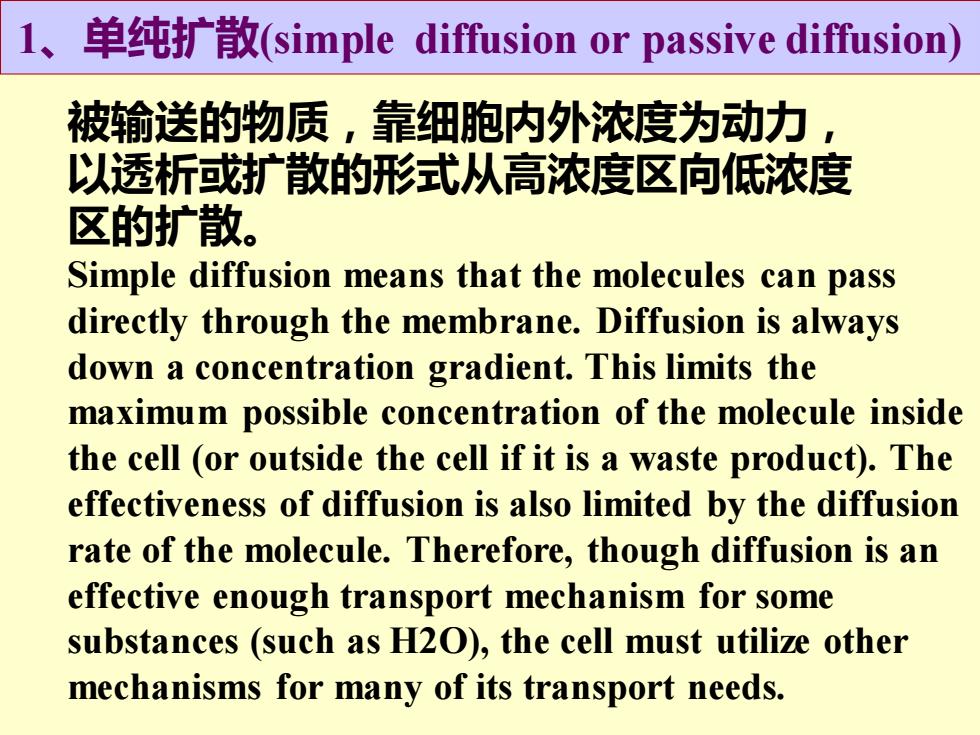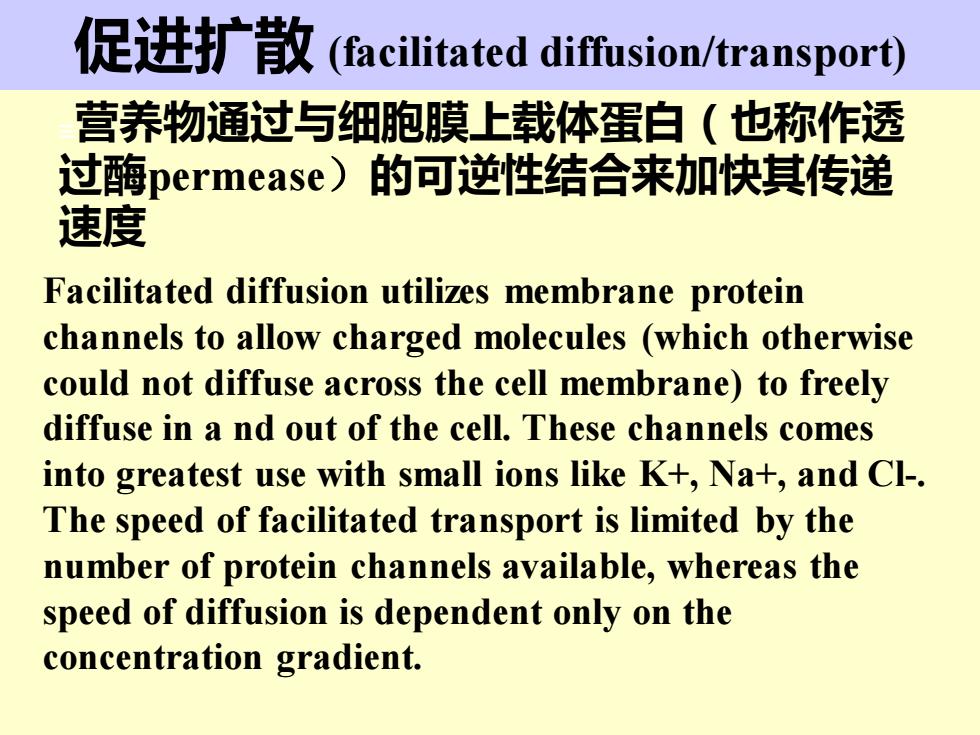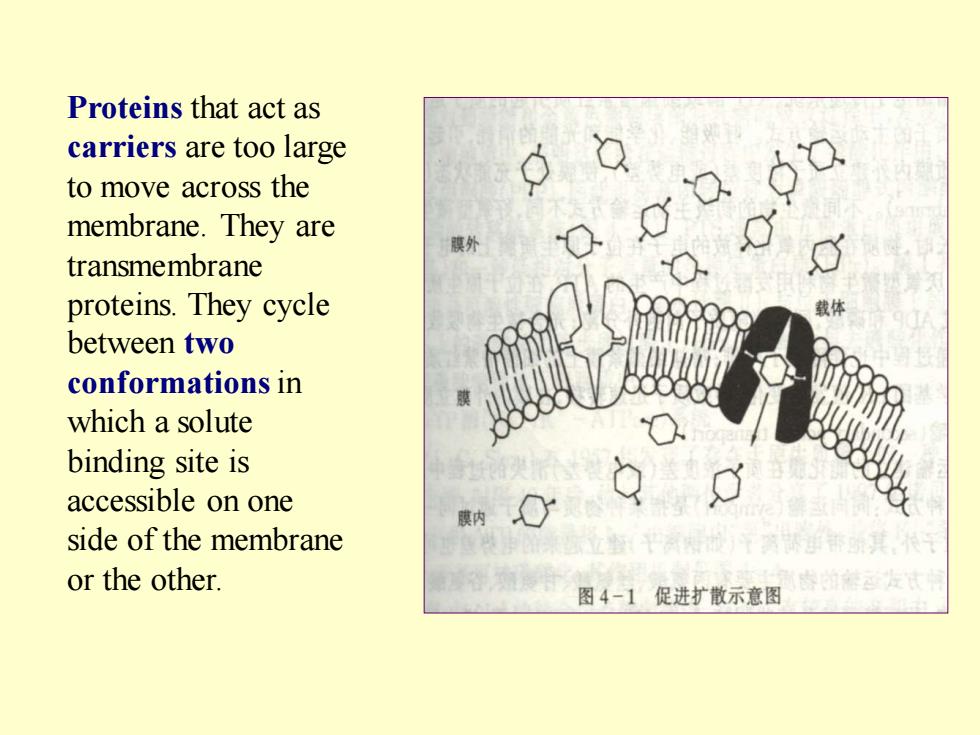
微生物吸收营养物质的方式
微生物吸收营养物质的方式

1、单纯扩散(simple diffusion or passive diffusion) 被输送的物质,靠细胞内外浓度为动力, 以透析或扩散的形式从高浓度区向低浓度 区的扩散。 Simple diffusion means that the molecules can pass directly through the membrane. Diffusion is always down a concentration gradient. This limits the maximum possible concentration of the molecule inside the cell (or outside the cell if it is a waste product). The effectiveness of diffusion is also limited by the diffusion rate of the molecule. Therefore, though diffusion is an effective enough transport mechanism for some substances (such as H2O), the cell must utilize other mechanisms for many of its transport needs
1、单纯扩散(simple diffusion or passive diffusion) 被输送的物质,靠细胞内外浓度为动力, 以透析或扩散的形式从高浓度区向低浓度 区的扩散。 Simple diffusion means that the molecules can pass directly through the membrane. Diffusion is always down a concentration gradient. This limits the maximum possible concentration of the molecule inside the cell (or outside the cell if it is a waste product). The effectiveness of diffusion is also limited by the diffusion rate of the molecule. Therefore, though diffusion is an effective enough transport mechanism for some substances (such as H2O), the cell must utilize other mechanisms for many of its transport needs

1、单纯扩散(simple diffusion or passive diffusion) 特点: ①扩散是非特异性的营养物质吸收方式:如营养物质通过细胞 膜中的含水小孔,由高浓度的胞外环境向低浓度的胞内扩散; ②在扩散过程中营养物质的结构不发生变化:即既不与膜上的 分子发生反应,本身的分子结构也不发生变化; ③物质运输的速率较慢:速率与胞内外营养物质的浓度差有关 ,即随细胞膜内外该物质浓度差的降低而减小,直到胞内外物 质浓度相同; ④不需要载体参与; 扩散是一个不需要代谢能的运输方式:因此,物质不能进行逆 浓度运输。 ⑤可运送的养料有限:限于水、溶于水的气体,及分子 量小,脂溶性、极性小的营养物质
1、单纯扩散(simple diffusion or passive diffusion) 特点: ①扩散是非特异性的营养物质吸收方式:如营养物质通过细胞 膜中的含水小孔,由高浓度的胞外环境向低浓度的胞内扩散; ②在扩散过程中营养物质的结构不发生变化:即既不与膜上的 分子发生反应,本身的分子结构也不发生变化; ③物质运输的速率较慢:速率与胞内外营养物质的浓度差有关 ,即随细胞膜内外该物质浓度差的降低而减小,直到胞内外物 质浓度相同; ④不需要载体参与; 扩散是一个不需要代谢能的运输方式:因此,物质不能进行逆 浓度运输。 ⑤可运送的养料有限:限于水、溶于水的气体,及分子 量小,脂溶性、极性小的营养物质

•smosis flows towards high salt concentrations
•smosis flows towards high salt concentrations

单纯扩散模式图 细胞膜外 细胞膜 细胞膜内
单纯扩散模式图 细胞膜外 细胞膜 细胞膜内

三营养物通过与细胞膜上载体蛋白(也称作透 过酶permease)的可逆性结合来加快其传递 速度 促进扩散 (facilitated diffusion/transport) Facilitated diffusion utilizes membrane protein channels to allow charged molecules (which otherwise could not diffuse across the cell membrane) to freely diffuse in a nd out of the cell. These channels comes into greatest use with small ions like K+, Na+, and Cl-. The speed of facilitated transport is limited by the number of protein channels available, whereas the speed of diffusion is dependent only on the concentration gradient
三营养物通过与细胞膜上载体蛋白(也称作透 过酶permease)的可逆性结合来加快其传递 速度 促进扩散 (facilitated diffusion/transport) Facilitated diffusion utilizes membrane protein channels to allow charged molecules (which otherwise could not diffuse across the cell membrane) to freely diffuse in a nd out of the cell. These channels comes into greatest use with small ions like K+, Na+, and Cl-. The speed of facilitated transport is limited by the number of protein channels available, whereas the speed of diffusion is dependent only on the concentration gradient

促进扩散(facilitated diffusion) 特点:在促进扩散过程中 ❖ 营养物质本身在分子结构上也不会发生变化 ❖ 不消耗代谢能量,故不能进行逆浓度运输 ❖ 运输的速率由胞内外该物质的浓度差决定 ❖需要细胞膜上的载体蛋白(透过酶)参与物质运输 ❖被运输的物质与载体蛋白有高度的特异性 ❖养料浓度过高时, 与载体蛋白出现饱和效应 促进扩散的运输方式多见于真核微生物中,例如通常在厌氧 生活的酵母菌中,某些物质的吸收和代谢产物的分泌是通过 这种方式完成的
促进扩散(facilitated diffusion) 特点:在促进扩散过程中 ❖ 营养物质本身在分子结构上也不会发生变化 ❖ 不消耗代谢能量,故不能进行逆浓度运输 ❖ 运输的速率由胞内外该物质的浓度差决定 ❖需要细胞膜上的载体蛋白(透过酶)参与物质运输 ❖被运输的物质与载体蛋白有高度的特异性 ❖养料浓度过高时, 与载体蛋白出现饱和效应 促进扩散的运输方式多见于真核微生物中,例如通常在厌氧 生活的酵母菌中,某些物质的吸收和代谢产物的分泌是通过 这种方式完成的

Embeded protein:
Embeded protein:

Higher Lower concentration concentration Diffusion through the lipid layer Lipid-soluble molecules such as O2 and CO2 diffuse freely through the plasma membrane. Diffusion through channels Some polar and charged molecules diffuse through protein channels that span the membrane.Water is a typical example Facilltated transport Certain molecules bind to a protein,triggering a change in protein shape that transports the molecule across the membrane.Glucose typically enters cells by this method. Copyright 2001 Benjamin Cummings.an imprint of Addison Wesley Longman,Inc

Proteins that act as carriers are too large to move across the membrane. They are transmembrane proteins. They cycle between two conformationsin which a solute binding site is accessible on one side of the membrane or the other
Proteins that act as carriers are too large to move across the membrane. They are transmembrane proteins. They cycle between two conformationsin which a solute binding site is accessible on one side of the membrane or the other